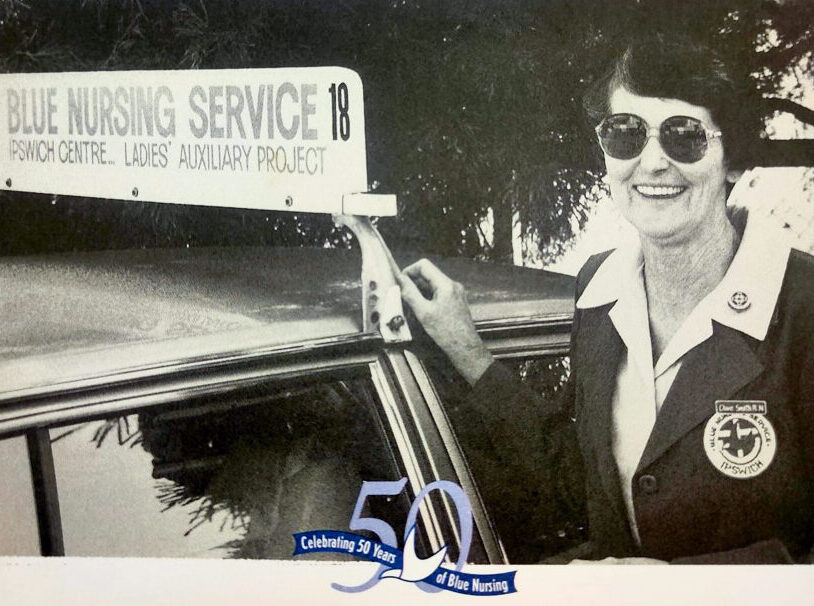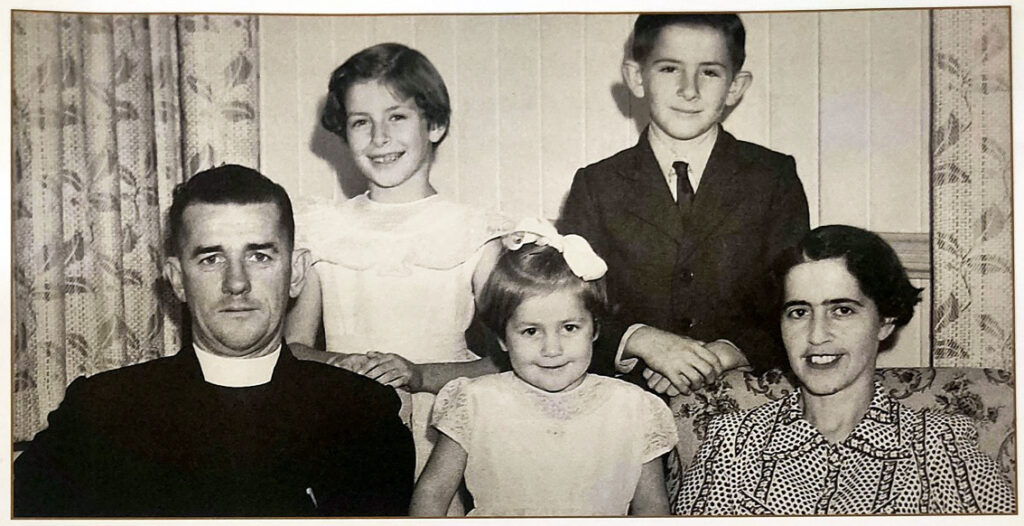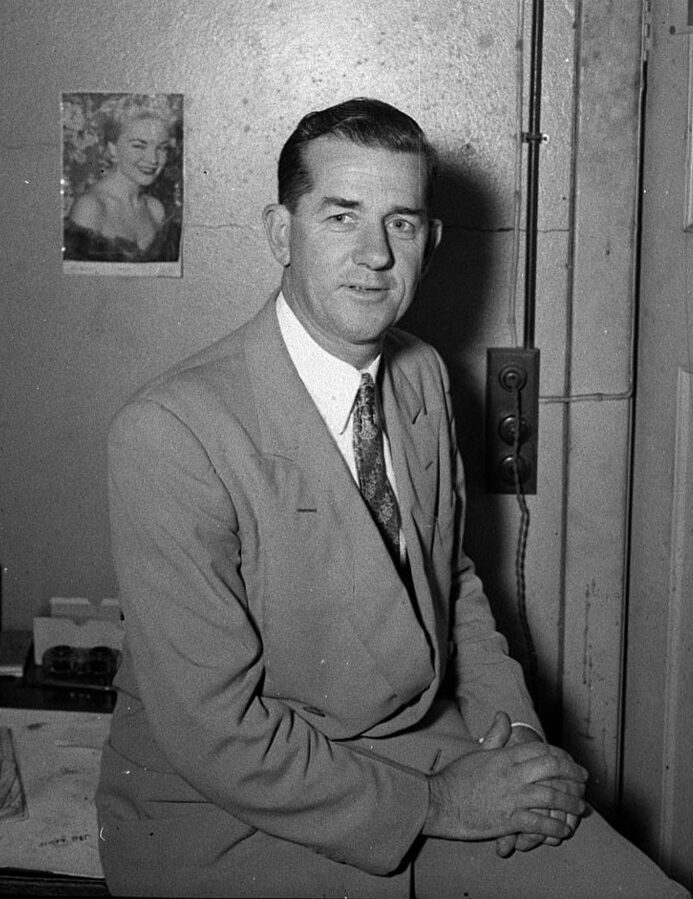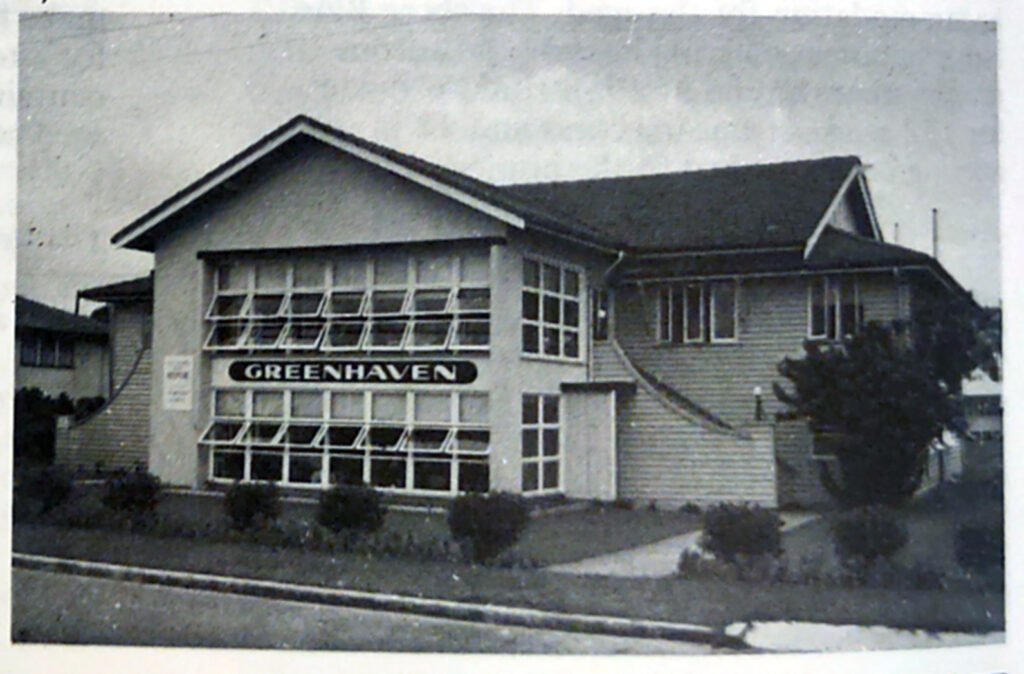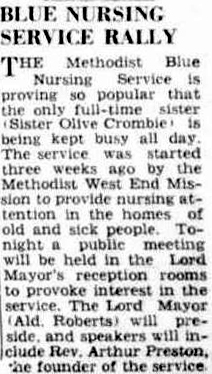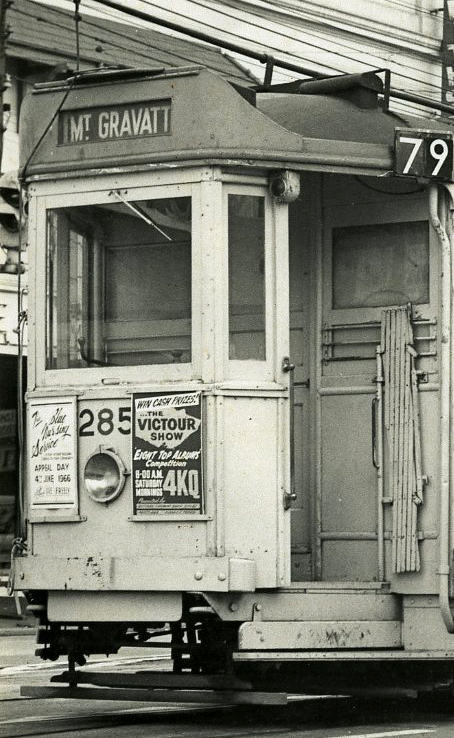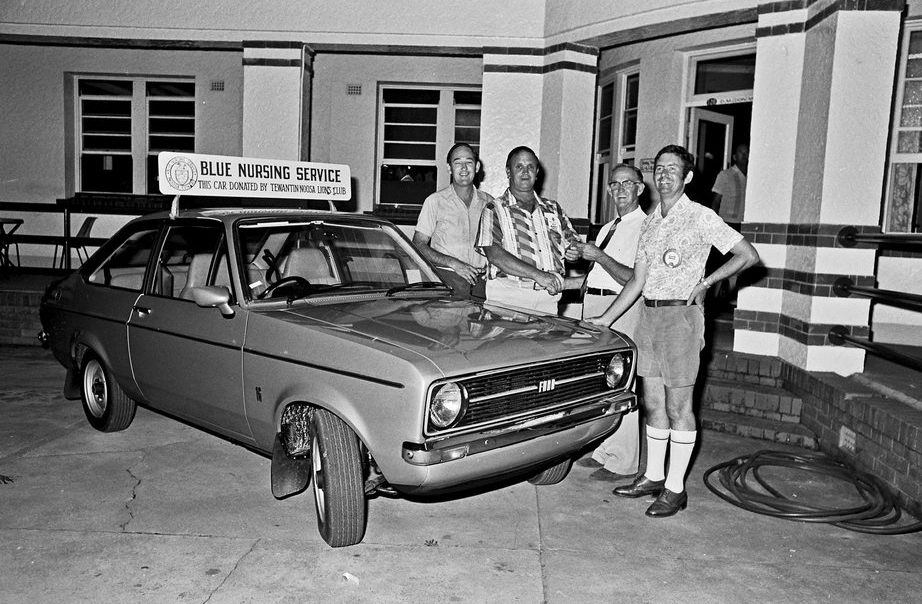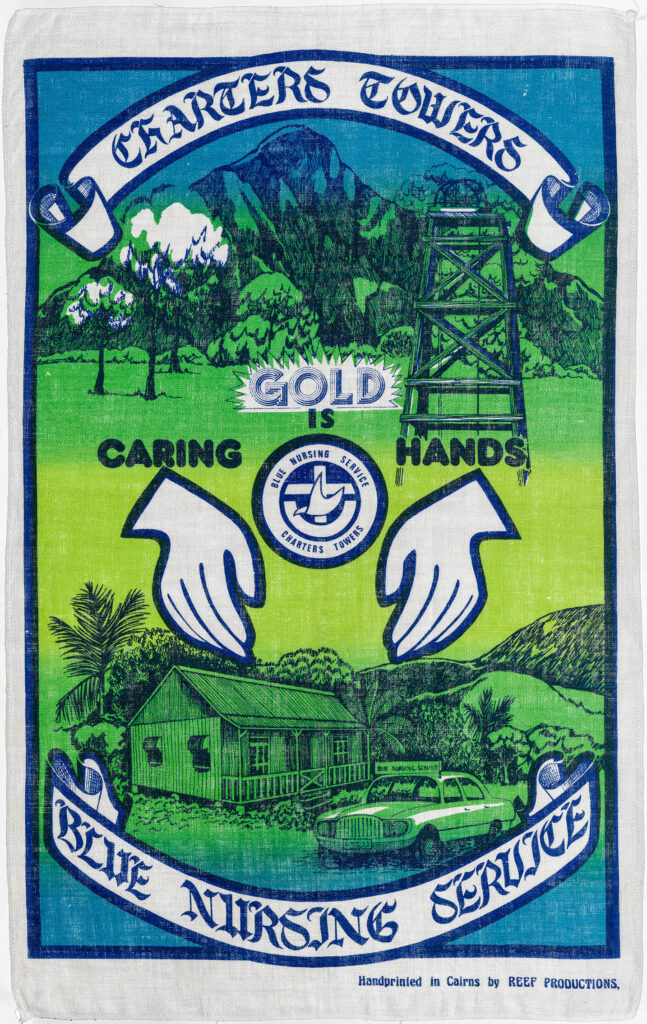Olive Crombie, Arthur Preston, and the Founding of BlueCare
Olive Crombie and Arthur Preston worked with the people of the West End Methodist Mission to establish the Blue Nursing Service in Queensland, now known as BlueCare.
By Raymond Reddicliffe
This is a 15 minute read, published June 2024.
On 20 August 2023, the organisation called ‘BlueCare’ celebrated seventy years as a major provider of professional domiciliary nursing and allied health care services throughout Queensland. A special celebration church service was held in the historic heritage-listed Uniting Church (formally Methodist Church) on the corner of Vulture and Sussex Streets, West End, Brisbane. This building complex proved to be an effective base from which the organisation began under the leadership of its founders.
This article will focus on the first decade (1953–1963) of the Blue Nursing Service. This timeframe coincides with when Olive Crombie was recruited to pioneer the Service in mid-1953; to when Reverend Arthur Preston, first Director-General of the Service, was farewelled from the West End Methodist Mission in December 1962. These visionary, committed, and energetic people played complementary roles as they worked together and engaged with others to pave the way for the phenomenal growth in the organization during its first decade and the remarkable developments that would follow.
The Queensland Synod of the Uniting Church in Australia (UCA) in 1999 approved the re-naming of the Blue Nursing Service as ‘Blue Care’. This change reflected the increasing importance and diversity of aged care related services being provided alongside its professional community and home nursing services. By retaining the word ‘Blue’ in its name, continuity with the Blue Nursing Service was proudly reaffirmed.
Sister Olive Crombie: Queensland’s first Blue Nurse
In 1953 at the age of 24, registered nurse Olive Crombie was selected and appointed by the West End Methodist Mission to pioneer a ‘hands on’ home nursing service to the sick, aged, poor, young mothers, and people with chronic illness or disability. Church records indicate that a small financial reserve of £30 had been set aside, which was sufficient to pay for only three weeks full-time work. Two weeks before the commencement of this service the Brisbane Telegraph (August 8, 1953, p.17) reported that the new nursing service would be modelled on Sydney’s ‘Angels in Blue’ operating in Newtown and Redfern and be funded by a community-wide appeal through print media and radio. Soon, the small sum set aside by the church had dramatically increased to £2,000, enough to fund the salary of a full-time nursing sister and the purchase of a vehicle for her use.
On August 23, 1953, with limited material resources but with a vital Christian faith and boundless enthusiasm for the nursing tasks at hand, Olive Crombie boarded a West End tram to meet and treat her first patient. As requests for home nursing increased, nursing staff and volunteers were recruited; and a second-hand Hillman sedan was generously donated by local business Redman Motors. By year’s end 1,000 home visits had been recorded, and the nursing team comprised six full-time and two part-time nurses. At the end of the first decade a record 205 calls on a single day were made from the West End Centre (Henley, 2015: 22); and 12 more Blue Nursing Service Centres were operating throughout Queensland (Anon., 2003: 6).
In the 50th Anniversary booklet (Anon., 2003: 1), Olive Crombie is described as a passionate pioneer who showed dedication to the Blue Nursing cause. Colleagues and clients testified to her deep commitment to providing professional nursing care to the needy as a matter of high priority. Olive recalled that in the early stages of the Blue Nursing Service three registered nurses volunteered to help on one weekend of each month. She willingly assumed the role of volunteer on the remaining fourth weekend in addition to her normal full-time duties. Olive affirmed that holistic care was always the original vision of Blue Nursing. With characteristic humility, she downplayed the importance of her own personal contribution in establishing the Service. She commented that she was really only part of a team and that the support and enthusiasm from the Mission carried her through.
Olive Crombie was renowned for her strong faith. BlueCare’s own institutional history describes her as blazing a trail with compassion and dedication through a conservative model of care in 1950s Queensland to reach those most in need (Anon., 2013: 7).
Certainly, Olive testified to having a strong sense of divine guidance in taking on the challenge of working in the unfamiliar field of home nursing, and was undeterred by the absence of any guarantees of employment beyond the three weeks initially offered. Olive whole-heartedly embraced the principle of ‘promoting and delivering quality caring services based on the compassion of Christ’ (Anon., 2003: 23).
Edith Olive Crombie was born in Brisbane on March 16, 1929. After primary and secondary schooling, she undertook basic nursing education and training at the Royal Women’s Hospital at Herston. Having gained accreditation as a mid-wife at the Epworth Hospital in Melbourne, Olive was invited to take up the newly created role of Director of Nursing at West End Methodist Mission. Nine months later, the increasing demands for the service and the willingness of Olive and her team to meet those requests for help are reflected in her comment: ‘We try to have a couple of days off each week, but you know how it is … someone is ill and needs care, and that’s that!’ (Truth (Brisbane), May 9, 1954, p. 42).
After three years of dedicated service with the West End Methodist Mission, and in view of her approaching marriage, Olive resigned and was succeeded in the role of Director of Nursing by Sister Ivy Robb. Reflecting on those first three years, Olive wrote: ‘I shall never doubt the power of God again. Faith in Him is a reality and prayer does change things!’ (Anon., 1963). Olive Crombie married Reverend Edward J. Smith who was appointed to Mareeba Methodist Circuit in North Queensland where the couple lived and worked for the next five years. Rev. Smith, accompanied by Olive and their children, also served in congregations at Raft Street, Toowoomba; Ingham; and Hermit Park in Townsville. In the late 1970s, the Smith family settled in the Ipswich area and Olive re-joined the staff of the Blue Nursing Service, where she served as Director of Nursing for over twelve years prior to her retirement in 1993.
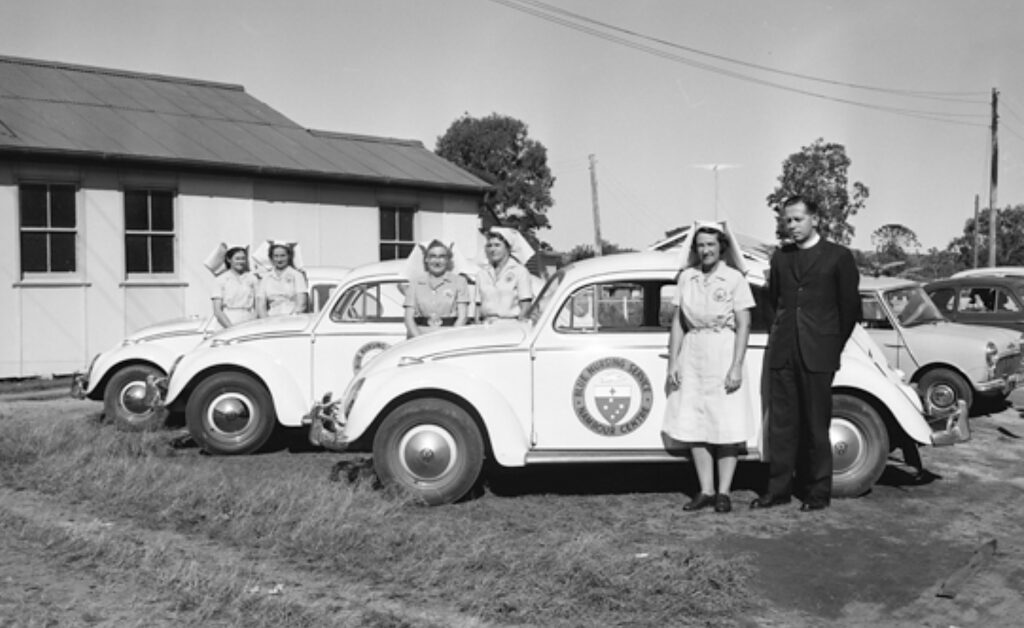
Figure 2: Blue Nursing Service, Nambour Centre staff, 1966 (photographer Bill Robinson, Sunshine Coast Libraries).
Meanwhile, Reverend Ed. Smith was working for the Queensland Uniting Church Synod as the Director of Crossroads, an organisation providing spiritual, social and practical support for young people and their families with intellectual or physical disabilities. Olive’s and Edward Smith’s outstanding contributions to Blue Nursing and to Crossroads Christian Fellowship were recognised by each being awarded an OAM in 1993. In active retirement, the Smiths were chiefly responsible for another significant community service initiative: establishing Barnabas House communities on the Gold Coast and at Durack in Brisbane. These small family-style groups comprised people with disabilities sharing common living areas with other residents who could function well in an independent living environment.
Following Olive Smith’s death on January 5, 2018, Craig Barke (CEO of Uniting Care Queensland) highlighted her role in laying the foundations for Blue Care, noting that the organisation had become one of Australia’s largest not-for-profit providers of aged care services. He also affirmed Olive’s Christian values and exemplary service that continued to be reflected in the values and mission of BlueCare. He said that Olive took on a bold and noble vision, with little resources and next to no assurances to help build a service dedicated to making a real difference to so many lives.
Many others played important roles in establishing the Blue Nursing Service in West End and in other locations throughout Queensland. Prominent among initial leaders were: Reverend Arthur Preston, Frank Godfrey, Roy Dinning, and Reverend Brian Whitlock, along with their respective family members and associates at West End Methodist Mission. There were also many other Church and community leaders and committed volunteers who participated in the movement.
Reverend Arthur Preston: Blue Nursing Service co-founder
Early in 1948, at the age of 35, Reverend Arthur Preston took up an appointment as Superintendent Minister of West End Methodist Circuit (Parish). At that time the Circuit comprised two small struggling congregations: West End and nearby Hill End. The West End Congregation comprised approximately forty regular attendees at Sunday Services; although in the 1920s, it had been one of the larger Methodist congregations in Brisbane with a vibrant history dating from 1885. Within a few months of arriving, Arthur Preston had organised a community survey of West End area; and in June 1948 he commenced the West End Community Centre. This venture involved offering study courses and cultural and recreational activities on two evenings each week. Early in 1949 a Day Kindergarten was begun in the West End Methodist Church Hall.
The Annual Queensland Methodist Conference in February 1952 resolved that the West End Circuit be constituted a Church Mission. Consequently, the usual limits on the length of the Superintendent Minister’s term would no longer necessarily apply. Having lived and worked in the West End Methodist Circuit for about five years; Arthur Preston’s contacts with church and community leaders were well developed. Also, he knew many governmental representatives and officials personally, and maintained regular communication with them.
The Blue Nursing Service began in response to widespread and pressing community health care needs. From humble beginnings, and without much fanfare, the domiciliary nursing service attracted community interest as well as financial and practical support. Within months it was reported that the founders were also thinking about establishing hospitals and nursing homes (Queensland Times, March 5, 1954, p.6), and had recognised the need for financial assistance from both Queensland State and Commonwealth Governments. The Service soon spread to other suburbs in Brisbane and to towns and cities throughout the State, and to Northern New South Wales.
Arthur Preston was widely acknowledged by his contemporaries as an outstanding Church and community leader with a strong proclivity towards meeting the spiritual, social, and physical needs of people in his local area and in the wider community. He received recognition in 1963 with the award of an OBE for community service and work among youth, and an OA in 1983. Arthur’s outstanding contribution in three Australian States was acknowledged posthumously at the Centenary of Federation Celebration in Canberra in 2001.
Arthur Preston’s Formative Years
Preston was born at Yeronga Park in Brisbane on October 14, 1912. He attended Eagle Junction State School, and due to family circumstances undertook an Apprenticeship in Upholstery in Fortitude Valley, Brisbane (Preston, N., 2006: 15). Arthur greatly valued his schooling and contacts with working class people, regarding them as crucial to enhancing his ability to communicate the Christian message (Preston, 1981: 1). At the age of 19, Arthur had a life-changing Christian conversion and became actively involved in the Hamilton Methodist Church. Believing he had received a vocation to ordained ministry, he undertook the requisite study and was received as a ministry candidate (Dingle, 1947: 217). From 1938 to 1940 he engaged in ministry training in the Methodist Theological Hall and the University of Queensland, displaying gifts and a passion for evangelism (Dingle, 1947: 221; Methodist Times, Dec. 27, 1962).
In 1941, the year of his ordination, Reverend Arthur Preston began serving in Mareeba Methodist Circuit in North Queensland, and the following year married Clare Green, daughter of Clara and William H. Green. Their generosity made possible the acquisition in 1956 of ‘Greenhaven’, a 26 bed Blue Nursing Hospital at Coolangatta. After a further year in Mareeba, the Prestons served in the West End Methodist Circuit in Townsville. From 1944 to 1947 Arthur was Field Secretary and Consultant for Evangelism with the Queensland Methodist Centenary Celebrations. He led over 100 evangelistic events and was credited with raising £100,000 for future Church mission projects.
Beginnings of the Queensland Blue Nursing Service
A few years after Federation, the Mothers’ Union District Nursing Association (the precursor of St. Luke’s Nursing Service) was active in parts of Southern Queensland (Longhurst, 2004). With another name change in 2012, the service became known as ‘Anglicare Southern Queensland’. Another early instance of domiciliary nursing operated in Darwin in 1929 with Nurse Constance Stone delivering nursing care in the homes of mothers and their infants (Burrows, 2018: 100).
According to Arthur Preston’s account of the beginnings of the Blue Nursing Service (Anon., 1963), on May 5, 1953 he arranged to meet with Reverend Sam McKibbin from Newtown, Sydney, who in 1949 had commenced the ‘Angels in Blue’ Nursing Service. Also at this meeting were Norman Brandon (West End Mission Treasurer) and Kathleen Anderson, a retired nurse. The group discussed the shortage of beds in hospitals and nursing homes in Queensland, and the urgent need for nursing care to people in their homes. Subsequently, Arthur Preston and Norman Brandon shared their creative plan with the Board of Management of West End Methodist Mission, and a proposal to underwrite the salary of a full-time nurse for the initial period of three weeks was endorsed. They also undertook to recruit a trained nurse to pioneer the new nursing service.
Arthur Preston emphasised that, although Blue Nursing was founded by Methodism, from its inception it was conceived as a service for the entire community, irrespective of class, colour, or creed. It was also decided that other sections of the community should be represented on the Blue Nursing Service organising committee. Further, it was resolved that these features be included in the organisation’s constitution for future reference. Arthur understood the nature and extent of the health care issues in his community and was aware of the negative impacts being widely experienced. He had a clear understanding of the major changes needed and was convinced that a whole of community response was necessary. He possessed the knowledge and skills to share his emerging vision with clarity and enthusiasm. So, when the urgent need for domiciliary nursing was presented, people from all walks of life and various religious and non-religious persuasions were motivated to respond. Donations of money and volunteers offering their time and skills helped transform the vision into practical reality.
Arthur’s vision of meeting community needs was framed in terms of his Christian faith and earnest desire to see the Kingdom of God extended. He regarded the new nursing service as a logical extension of the church ministry he and members of West End Methodist Mission were already undertaking (Brisbane Telegraph, August 8, 1953, p.17). Reflecting on four decades of ministry towards the conclusion of his ministry at Wesley Central Mission in Melbourne, Arthur wrote: ‘From the beginning I understood that I must preach a whole gospel. That is to say, it must have both a personal and social emphasis’ (Preston, 1981: 2). In his view, to highlight one dimension without duly acknowledging the importance of the other rendered either approach unsatisfactory.
The impact of Arthur Preston’s vision, faith, and courage, demonstrated in the founding the Blue Nursing Service, extended to a daunting list of other projects. These included the growth of the West End Methodist Congregation from 40 to 400 attendees; leading the ‘Mission to the Nation’ in Queensland in 1953; initiating the outreach Ministry at the Lyric Theatre in 1955 (see preface by A. Walker in Preston, 1956); launching the Teenage Cabaret Ministry at West End in 1960; commencing Lifeline in Adelaide in 1964; and establishing the first Nursing Home in the world dedicated to the care and treatment of patients with Huntington’s Disease, in Melbourne in 1981.
West End Methodist Church
The official opening of the West End Methodist Church, a brick and stone building located on the corner of Vulture and Sussex Streets took place on November 15, 1885, at a cost of £2,500. In the previous year, Rev. C. Wiles from the adjacent Stanley Street Methodist Circuit had commenced church services in a private home in the West End area. Within months a committee was formed to work towards purchasing a prospective church site and erecting a suitable church building (Dingle, 1947: 225).
The adjacent School Hall was built and opened in 1901 at a cost of £60. Both properties underwent significant renovations during the years in which Arthur Preston served in the West End Methodist Mission. More space was created on the eastern side of the church, and the construction of a gallery above the main entrance also increased seating capacity. Renovations to the school hall involved construction of new office space and, at ground level, refurbishment for regular cabaret youth programs and other activities. The cost of these projects was in the vicinity of £25,000, to be repaid with a 20-year loan (Henley, 2015: 19).
BNS: change and development
Within a few years of its commencement, there were signs that additional capacity was needed to ensure the Blue Nursing Service would continue to develop and expand in response to emerging community needs. For example, the need for more guidance and direction for the opening of new centres was highlighted when the proposal to establish the Blue Nursing Council was approved by the Annual Methodist Conference early in 1957. Another pressing issue was the need for a centralised body to receive and disburse grants from State and Commonwealth Governments. The acquisition of land and erection of buildings for Aged Care facilities and Nursing Homes were also factors that required consideration.
It is noteworthy that the composition of the new Council was modelled on the Annual Queensland Methodist Conference when it met in Session. It would comprise the President, Secretary, and Connexional Secretary (a full-time officer responsible for administration of the Church’s finance, property, and legal interests). Because these key roles were classified as ministerial appointments, an equivalent number of lay representatives were appointed to the Council. Also, each Blue Nursing Service Centre Director and a lay person from the Quarterly Meeting of the local congregation to which a Centre was attached would represent their Centre at Council meetings.
Each Blue Nursing Centre was guided by a constitution based on a template document produced by a member of the original Blue Nursing Service Committee with legal training and experience. The Council had responsibility for drafting a model constitution for centres for approval by the Standing Committee of the Methodist Conference. A Resolution was adopted that any Circuit, Circuit Mission or Home Mission Station intending to establish a Blue Nursing Centre, must first receive the approval of the Blue Nursing Council and the Standing Committee of the Queensland Methodist Conference before proceeding.
When the Annual Conference re-convened the following year, Arthur Preston’s Report as Director-General led with the following paragraph (Qld. Methodist Church Conference Minutes, 1958: 95):
The Blue Nursing Service is proving itself to be one of the most popular forms of social service yet undertaken by the Methodist Church in Queensland. Reaching beyond the bounds of denominationalism to all sections of the community it has won the goodwill of the general public irrespective of class or creed.
A further observation was made about the growth and expansion of the Service being ‘phenomenal’ during the previous four years. Centres were operating in West End (Brisbane), Ipswich, Toowoomba, Sandgate, Wynnum, Southport, and Coolangatta; and enquiries were being received from other locations. The first centre established beyond the Brisbane metropolitan area began in Ipswich city in October 1954. This initiative was supported by a gift of £10/10/- from the West End Methodist Church, and this new centre immediately began functioning independently (Queensland Times, October 7, 1954, p.2), thereby setting a precedent for other new Centres.
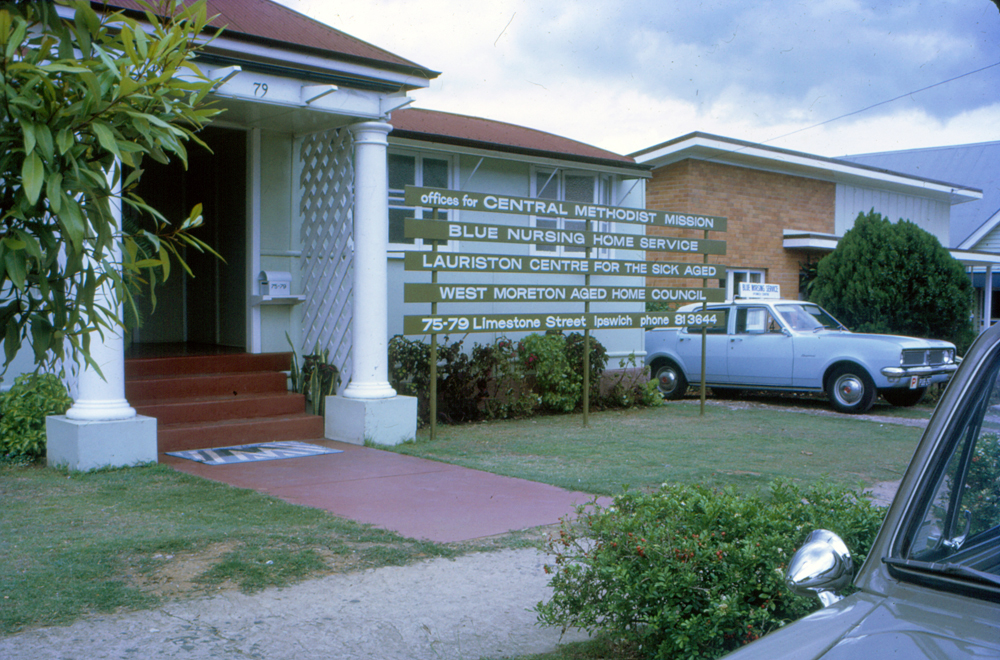
Figure 10: Offices for the Central Methodist Mission Blue Nursing Home service, Ipswich, 1970 (photographer Kerry Smith, Picture Ipswich).
Key factors of success
The success of the Blue Nursing Service in Queensland was due to a combination of factors, prominent among which would have been the inspirational and visionary leadership of co-founders, Olive Crombie and Arthur Preston. The enormous value of their personal contributions and extent of their positive influence associated with the beginnings of the Blue Nursing Service in Queensland extended to what each achieved in respect to other community service initiatives.
Other key factors and circumstances were important, especially during its first decade. The BNS recognised the home nursing needs of early discharged hospital patients, at a time when such care was routinely neglected. Services were offered without discrimination to those in need. Volunteers were recruited broadly, from Methodist congregations, other local churches, and the wider community. Methodist ministers, pastors, and other leaders served as part-time Centre Directors, and office space was made available in church halls, unoccupied parsonages, or in private homes. The establishment of a State-wide BNS Council by the Queensland Methodist Church was significant, and at the local level the West End Methodist Mission and other Centres accessed government grants and donations from annual appeals. Fund-raising by BNS Women’s Auxiliaries equipped Centres and helped purchase vehicles.
BlueCare remains an integral component of Uniting Care (the Uniting Church Queensland Synod’s mission and community service organisation). The vision of the founders included the provision of hospitals and convalescent homes for those needing them. A significant feature of the history of the Blue Nursing Service (and of BlueCare) has been the maintenance of strong links with the Queensland Methodist Church, and subsequently with the Uniting Church in Queensland. With the expansion of the service by accessing governmental funding, in 2023 BlueCare has approximately 8,600 employees delivering more than ten service programs. The involvement of local congregations and opportunities for volunteers to serve in local centres has also changed. Nevertheless, the level of volunteer involvement is quite significant with the number at 546 cited in the Report issued in August, 2023 (Anon., 2023: 7).
Several other community home nursing services were established in Queensland during the twentieth century. These include Oscare (St. Vincent de Paul Society of Queensland), Anglicare Southern Queensland (Anglican Church of Queensland), and Karuna Hospice Service (affiliated with Foundation for the Preservation of the Mahayana Tradition), to name a few. Along with BlueCare these organisations strive to deliver high quality professional home nursing and allied health care services as not-for-profit organisations to patients and clients in the communities they serve.
Sources and further reading
Anon. 1963. Tenth Anniversary of Blue Nursing Service: 1953–1963. Brisbane: Blue Nursing Service.
Anon. 2003. Blue Care: 50 Years of Care. Milton, QLD: Blue Care.
Anon. 2013. 60 Years of Blue Care. Brisbane: Blue Care.
Anon. 2023. Blue Care at 70. Brisbane: Blue Care.
Burrows, D. 2018. Nurses of Australia the Illustrated Story. Canberra: NLA Publishing.
Dingle, R.S.C. (ed.). 1947. Annals of Achievement: A Review of Queensland Methodism 1847–1947. Brisbane: Queensland Book Depot.
Henley, E. 2015. 130thAnniversary of West End Uniting Church, 1885–2015. Brisbane: West End Uniting Church.
Longhurst, R. 2004. Fuelled by Passion: A History of St Luke’s Nursing Service 1904–2004. Brisbane: St. Luke’s Nursing Service.
Preston, A. 1956. Plain Talks for the People. Brisbane: Smith and Paterson.
Preston, A. 1961. We Offer Christ. Brisbane: Smith and Paterson.
Preston, A. 1981 (October). Action: The Voice of Wesley Central Mission [Melbourne], 1–8.
Preston, N. 2006. Beyond the Boundary: A Memoir Exploring Ethics, Politics and Spirituality. Burleigh, Qld: Zeus Publications.
Related articles


